Previous Post Next Post
Saturday, January 17th, 2009
Aron Namenwirth at Vertexlist
“Made in U.S.A” Williamsburg, Brooklyn
December 14, 2008: I arrived at the gallery and spoke with Marcin Ramocki, the founder of the gallery while waiting for Aron to arrive.
Erika Knerr: Is this the old Four Walls Space?
Marcin Ramocki: Yes, it was Four Walls until 1999, then Leo Koenig’s first space in 1999, then Mike Ballou’s Film and Slide Club, then Vertex List since 2003. I did five years and I just passed the space on to a friend of mine, Charles Beronio, who’s going to do the next five years.
EK: And will it remain vertexList?
MR: Yes. We are starting our second five years. Charles is already the director and Sunday is my day to be here. For me five years of an artist running a gallery is enough.
(Phone rings) That’s Aron. What’s up? He’s coming here.
EK: How often did you do shows, was it a full schedule?
MR: We’re open 3 days a week and we had 8-9 shows a year. This space took off. It’s a great location because everybody knows it as Four Walls.
EK: It’s a great legacy to have especially as an artist run space. Is the new director also an artist?
MR: Yes, he’s an artist and has his studio in the back.
EK: How was the opening last night?
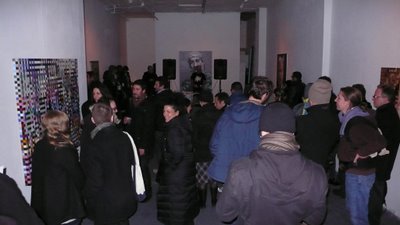
EK: It’s been a long time since I’ve been here.
Brian Conley: There were a lot of intense characters.
BC: Who was that?
BC: This was non-profit?
I got an email this morning from Amy Sillman apologizing for not being at the opening last night.
AN: She wouldn’t be afraid to do that?
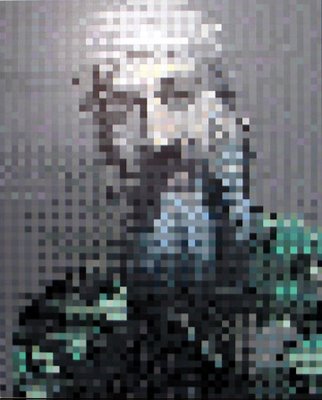
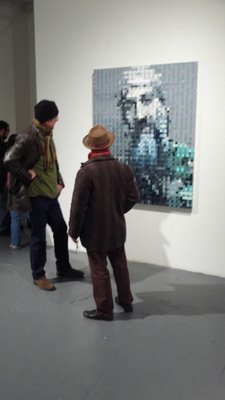
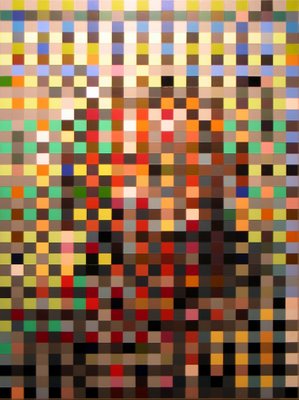
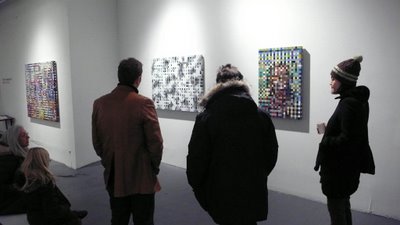

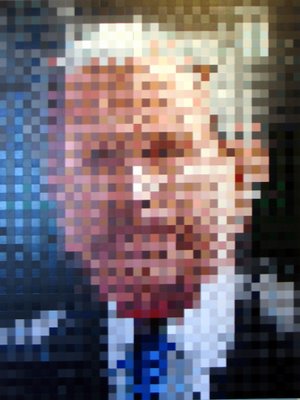
So I did this painting. This was the first of the figurative paintings, George Bush. I picked a subject of someone a totally despised. The painting came together almost effortlessly, because I had been working with these pixels for a while. I had a figurative image, where the orientation of the painting was predetermined. Like these [the combined paintings] the images are rotated. In the landscape paintings, I would turn them.
EK: You mean the image could be upside down.
AN: Yeah, I didn’t want to have a horizon line. I didn’t want them to be recognizably landscape. I wanted them to be completely open so your mind can infinitely put together different kinds of images, like bunny hunting. Something that was really bad about abstract painting, I wanted there to be bunny hunting that could happen.
With the George Bush painting it completely came together. It was so much easier for me to make the painting, because I knew exactly what I was doing with it. But then when I got the image I was completely horrified with it, of having George Bush in my studio and he’s been there for three years, looking at me. So I wasn’t sure if this was a good move.
Perry Hoberman came over and he said, “This is a terrible idea, this is too obvious, you’ve moved your work in a terrible direction. “You are making a one liner.” “He’s like a mug shot.” I made him like a mug shot so he would look a criminal, which he is. So here I had this painting. I tried flipping it upside down, but then we have George Bazelitz. So I just made another painting Osama Bin Laden, which was much more successful, he’s another villain, but works on many different levels.
The first Paintings I used the mosaic filter. I was doing them ass backwards, some cockamamie way and Marcin said, “You know there’s a filter in Photoshop for that process, just use mosaic. I just used a really simple filter to create the pixelation. I took an image that was small and blew it up and mosaiced it so I could get the one-inch square.
EK: Did you project it?
AN: No, I laid out a coordinate map, and I numbered the pixels on the top and sides and bottom. I wanted to have a one to one correspondence with the actual source, so I took a really small picture of Bin Laden that when blown up to five by four feet, the actual pixels, are what you’d be seeing. There wouldn’t be any filter used, so it would be what it is. There would be no translation.
EK: Was it a black and white image?
AN: The color is just what it was. I did change the photo. He originally had a rifle, but when it was translated he looked like he was flipping the bird at the viewer because the rifle blended into the background. I wanted the image to be more neutral, so I erased that part of the painting. I wanted to paint a picture of Bin Laden that wasn’t blatantly antagonistic, or confrontational. I also thought this painting reminded me, with the light and the color, of El Greco, or a Byzantine painting. There’s also an ambiguity about it. People don’t really get it. It’s not like the Bush were you could see it immediately. We are also conditioned to recognize Bush’s image, but with Bin Laden there are not that many pictures of him and he’s a specter. If you do a Google search for him only a handful of images come up.
Next I did the Hillary painting. I wasn’t really sure how I felt about her. I again picked a very small picture of her from her website. I did change the color. I wanted to make her more sensual. I was thinking of Hillary/Marilyn Monroe ala Andy Warhol
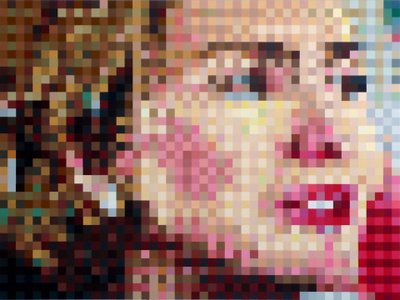
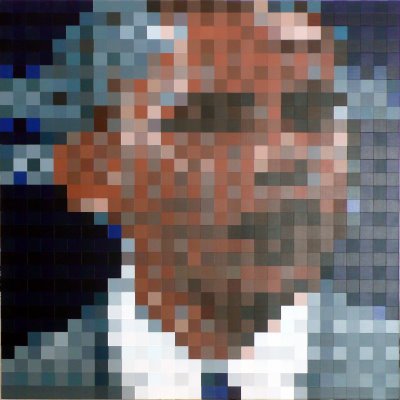
Aron Namenwirth is a painter, media artist, curator, and co-director of artMovingProjects founded in 1995. Aron was born in Ipswich Mass. He got his M.F.A. in Painting in 1987 from Yale. He works and lives in Williamsburg, Brooklyn. Aron’s work is involved in contemporary American politics, war and consumerist culture. He recently showed at Momenta, vertexList. and Galapagos. Namenwirth’s Video and Animations have been screened at Diva in Miami. He has written and curated for Zing Magzine. His work has been reviewed in The New York Times, The Brooklyn Rail, Time Out, Italian Vogue, and Broadcast on PBS and CNN. http://aronnamenwirth.blogspot.com/
ABOUT VERTEXLIST: vertexList is an artist-run space in Williamsburg Brooklyn, founded in 2003 by Marcin Ramocki with a mission of supporting emerging media artists. Currently the gallery is directed by Charles Beronio and seeks artwork conceptually involved in exposing the codes of post-capitalist culture, both via new and traditional media. vertexList is named after the property of a vector image which holds all numerical information about the image. http://www.vertexlist.net/, http://vertexlist.blogspot.com/
“Made in U.S.A” Williamsburg, Brooklyn
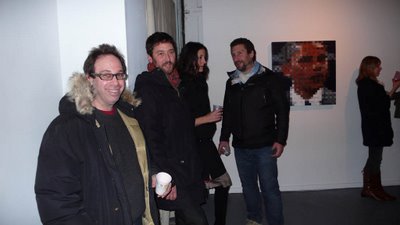
Aron Namenwirth, Jay Davis, Kelly, Dan Kopp and “Obama”
138 Bayard Street, Brooklyn NY 11222
“Made in U.S.A” on display until February 1, 2009
http://www.vertexlist.net/
by Erika Knerr
December 14, 2008: I arrived at the gallery and spoke with Marcin Ramocki, the founder of the gallery while waiting for Aron to arrive.
Erika Knerr: Is this the old Four Walls Space?
Marcin Ramocki: Yes, it was Four Walls until 1999, then Leo Koenig’s first space in 1999, then Mike Ballou’s Film and Slide Club, then Vertex List since 2003. I did five years and I just passed the space on to a friend of mine, Charles Beronio, who’s going to do the next five years.
EK: And will it remain vertexList?
MR: Yes. We are starting our second five years. Charles is already the director and Sunday is my day to be here. For me five years of an artist running a gallery is enough.
(Phone rings) That’s Aron. What’s up? He’s coming here.
(Aron was watching his gallery artMovingProjects…) http://www.artmovingprojects.com/ (…which opened John Giglio’s thoughtful show, “Designing Heaven,” the night before.)
EK: How often did you do shows, was it a full schedule?
MR: We’re open 3 days a week and we had 8-9 shows a year. This space took off. It’s a great location because everybody knows it as Four Walls.
EK: It’s a great legacy to have especially as an artist run space. Is the new director also an artist?
MR: Yes, he’s an artist and has his studio in the back.
EK: How was the opening last night?

Mary Baronne and Tom Moody
MR: It was good. We had about 100 people. There was also a performance by Glomag. http://glomag.com/. It’s much easier for me now because there’s less pressure since I’m not in charge. I still do everything that’s online, we have a blog http://vertexlist.blogspot.com/, so I still write that. Sometimes the blog gets rolling and sometimes we’re all doing other things. This has been a nice, interesting adventure; it was five years of my life. You’re welcome to check out the back, you probably know the way.
EK: It’s been a long time since I’ve been here.
I went to the back and reveled a bit in my memory of attending Four Walls events there and was introduced to Brian Conley, who Marcin interviewed for his documentary on the Williamsburg Art scene premiering at MOMA on February 25, 2009. Aron arrives to do the interview and talk to me about his show, but we end up bull shitting in the back room for an hour with beers beforehand.
Aron Namenwirth: I came to New York in 1987. I was living in New Jersey, but half my friends were here in Williamsburg. We all left Yale in 87 and I moved to Hoboken with John Currin, Lisa Yuskavage, Matvey Levenstein, and Joe Begonia. We split up, half of us, like Jim McShea and Dik Liu and some of my other friends where here, so I would be coming out here as much as I was going to the Lower East Side, which was also what was going on then, so I’d just come over the Williamsburg Bridge. It was really fun. It freaked me out a little bit, some of the stuff that was happening on the waterfront, the movies they were showing about sex change operations and penile insertions. I was pretty green back then.
Brian Conley: There were a lot of intense characters.
AN: There was this place called the Freezer that was a little space upstairs on Grand Street. It wasn’t a gallery proper. It was a performance space. People would do performance art. Then at the gallery that I moved into, artists were coming by all the time to pick up there work, which I didn’t have and the place was just trashed and the city was coming after me because they had given them all this grant money for gear and they took the money and split.
BC: Who was that?
AN: I don’t want to name any names. They got all this money at the very end. It was a time when spaces like Brand-Name Damages and Minor Injury finally started receiving money.
BC: This was non-profit?
AN: I don’t know if they had status but they got grants and what they did was bought really expensive video recording equipment, TVs, stereo equipment and then they just split. They bought gear for themselves and they closed up shop. Then I was getting these letters? That was the early years.
I got an email this morning from Amy Sillman apologizing for not being at the opening last night.
MR: Amy, Amy’s interview was awesome. She’s the one (in the documentary) that dished some dirt.
AN: She wouldn’t be afraid to do that?
After an interesting dialogue about Brian Conley’s project in the Middle East we get back to Aron’s Show.
MR: You saw Osama Bin Laden out front in the gallery? No one can tell it’s Osama Bin Laden.


(left) “Osama Bin Laden,” (right) John Berens w/ Bin Laden
AN: I had a guy all the way at the other end of the gallery saying, “is it Santa Claus? Castro?”
BC: That’s Obama at the other end right? He’s got the George Washington curls?
AN: Yeah, it’s Obama, Hillary Clinton, Bush, Bin Laden. And there’s the Spirit Surfers.
MR: And the abstract stuff.
AN: It’s not abstract stuff. It’s imagery. “Spirit Surfers” is all these religious leaders. Jesus, from Jesus Christ superstar, which I noticed their doing again, Mohammed, Buddha, Martin Luther King and Osama again and they’re all competing in this one little painting. It becomes a blurry face.
BC: That’s Obama at the other end right? He’s got the George Washington curls?
AN: Yeah, it’s Obama, Hillary Clinton, Bush, Bin Laden. And there’s the Spirit Surfers.
MR: And the abstract stuff.
AN: It’s not abstract stuff. It’s imagery. “Spirit Surfers” is all these religious leaders. Jesus, from Jesus Christ superstar, which I noticed their doing again, Mohammed, Buddha, Martin Luther King and Osama again and they’re all competing in this one little painting. It becomes a blurry face.

“Spirit Surfers”
BC: What? Did you just map them all on top of each other?
AN: Each one occupies a different grid and so there are four grids.
BC: So they’re not on top of each other, they are beside each other.
AN: They’re next to each other. Each one occupies one of the four gr ids, then it repeats. So you’re just getting one fourth of the information. And then there are five images in this painting, so one is completely covered. Mohammed is completely covered by Martin Luther King? I’m particularly fond of that painting. I just can’t stand organized religion. It seemed like a nice way to deal with it.
BC: So you went to Yale? Who did you study with there?
AN: I’d say the people now that had the greatest impact on me would be Mel Bochner and Andrew Forge and Jake Berthot.
BC: That was a really divergent group.
AN: Yeah, really divergent. Everyone was in complete disagreement. William Bailey was there. That was one of the first things I noticed when I started doing studio visits, because I would line them up boom, boom, boom, one after the next and I’d take notes and I noticed how they would completely contradict each other. So I became very skeptical of any kind of criticism at that point because there was no consensus. It was really confusing to be a student there then. The sculpture department was really good and I hung out over there. Oh, and Veja Celmins was one of my favorite teachers there. She was great to have in the studio.
BC: I’m sure Mel Bochner was pretty hardcore.
AN: He was totally hardcore but he saved my ass because?
BC: This was in the 80’s right? He was doing those terrible paintings then.
AN: Yeah the 80’s. I didn’t have any work after my first semester and they did these pit crits and I just had all this crap on the floor of my studio. Everyone else had seven paintings that they put up and I didn’t have crap. I just had all these drawings and they were all crumpled and they were all over and I was freaked because it was my turn. My friends dragged all my work out of my studio and left it on the floor of the pit and the faculty was silent. No one had anything to say. And I didn’t have anything to say. It was one of those incredibly awkward silences and then Mel Bochner says, “This is the most interesting work of this class”. And then all of the sudden everyone had all these great things to say. They’d pick up one little thing and pass it around. It looked like scatter art?
EK: Do you want to talk out front, Aron, with the work… This is the piece you were talking about with the intermix of religious icons? I love this piece. The body of work is great together as a whole show. I think it’s really cool that it’s come together in this moment.
AN: Each one occupies a different grid and so there are four grids.
BC: So they’re not on top of each other, they are beside each other.
AN: They’re next to each other. Each one occupies one of the four gr ids, then it repeats. So you’re just getting one fourth of the information. And then there are five images in this painting, so one is completely covered. Mohammed is completely covered by Martin Luther King? I’m particularly fond of that painting. I just can’t stand organized religion. It seemed like a nice way to deal with it.
BC: So you went to Yale? Who did you study with there?
AN: I’d say the people now that had the greatest impact on me would be Mel Bochner and Andrew Forge and Jake Berthot.
BC: That was a really divergent group.
AN: Yeah, really divergent. Everyone was in complete disagreement. William Bailey was there. That was one of the first things I noticed when I started doing studio visits, because I would line them up boom, boom, boom, one after the next and I’d take notes and I noticed how they would completely contradict each other. So I became very skeptical of any kind of criticism at that point because there was no consensus. It was really confusing to be a student there then. The sculpture department was really good and I hung out over there. Oh, and Veja Celmins was one of my favorite teachers there. She was great to have in the studio.
BC: I’m sure Mel Bochner was pretty hardcore.
AN: He was totally hardcore but he saved my ass because?
BC: This was in the 80’s right? He was doing those terrible paintings then.
AN: Yeah the 80’s. I didn’t have any work after my first semester and they did these pit crits and I just had all this crap on the floor of my studio. Everyone else had seven paintings that they put up and I didn’t have crap. I just had all these drawings and they were all crumpled and they were all over and I was freaked because it was my turn. My friends dragged all my work out of my studio and left it on the floor of the pit and the faculty was silent. No one had anything to say. And I didn’t have anything to say. It was one of those incredibly awkward silences and then Mel Bochner says, “This is the most interesting work of this class”. And then all of the sudden everyone had all these great things to say. They’d pick up one little thing and pass it around. It looked like scatter art?
EK: Do you want to talk out front, Aron, with the work… This is the piece you were talking about with the intermix of religious icons? I love this piece. The body of work is great together as a whole show. I think it’s really cool that it’s come together in this moment.

Mary Alpern, John Illig, Erika Knerr, Sakurako Shimizu
Photography: John Bailey
Photography: John Bailey
AN: Well I finished most of the show in 2007. I didn’t work on much of the show at all this year.
EK: When did you do Obama?
AN: I did Hillary and Obama at the same time. I did her first and then he followed. They were both finished before he won New Hampshire. I thought she was probably going to win, but I liked him better. He was my first choice. Then when he won I was disappointed that he didn’t pick Hillary for his VP.
EK: Then you thought, now I have to do a Biden? lol
AN: No, No, there isn’t going to be a Biden.
EK: It’s not going to continue, this project?
AN: I don’t know. I never know. I doubt that I would just sever it, but I’ve been working on this work for 6-7 years. I’ve done 2 other previous shows of work that led up to this. They were more like this one, North and South. They are stills from the North Pole and Antarctica, different glacial landscapes from both locations. Basically the images all occupy one of these four pixels so there are four images sitting next to each other on four separate grids and they just obliterate each other.
EK: When did you do Obama?
AN: I did Hillary and Obama at the same time. I did her first and then he followed. They were both finished before he won New Hampshire. I thought she was probably going to win, but I liked him better. He was my first choice. Then when he won I was disappointed that he didn’t pick Hillary for his VP.
EK: Then you thought, now I have to do a Biden? lol
AN: No, No, there isn’t going to be a Biden.
EK: It’s not going to continue, this project?
AN: I don’t know. I never know. I doubt that I would just sever it, but I’ve been working on this work for 6-7 years. I’ve done 2 other previous shows of work that led up to this. They were more like this one, North and South. They are stills from the North Pole and Antarctica, different glacial landscapes from both locations. Basically the images all occupy one of these four pixels so there are four images sitting next to each other on four separate grids and they just obliterate each other.

“Party City”
“Party City” is also four images, a Chinese stockbroker, guys with suits with golden shovels breaking ground for the Chinese version of the NASDAQ, the
building is designed by Rem Koolhaus, and a group of soldiers from Darfur with shovels and guns. All these images are off the internet. The fourth image is a group of people, friends of my mom’s Cynthia Bloom at her memorial service. I planted all these flowers in the sand, so all these people where around the flowers in the sand thinking about her.
EK: When did your mom die?
AN: In July. So that was the last image, I painted that image over the last image of the stockbroker. I finished this one in the fall about a month before I knew about the show here. It was an all black painting at one point. I started it in 2006. This is one of the earliest ones but I kept working on it and it evolved. At first it was more morose and now I think of it more like the Mexican day of the dead, a celebration of death. The subject matter is death ridden, but I see it as a positive thing.
I wasn’t sure if I was going to paint anymore, because there are a lot of other things I like to do too. My media works and writing.
EK: I like your blog, I check in on it every so often.
AN: It’s sadly honest.
EK: I love it. That’s what’s great about it.
AN: I love it too, but don’t want to perseverate on it. I just write it and get it out there. It seems when there is a spelling mistake the reader loses faith so I will work on that. In terms of the paintings I’ll tell you how it all happened. After I did the first show at VertexList 2005, I was thinking that I really needed to make the subject matter of the paintings more clear. I felt like I was hiding, I was creating eye candy. I was thinking of them like Trojan horses, a way to deliver content into the world in a way that it could exist and be accepted and I began to think of that as cowardice. I wanted to bring the subject matter to the surface and see how that felt.
EK: You felt like you were obliterating the image?
AN: Yeah, the paintings that preceded these had all this really heavy content like wounded children in Israel being worked on, images from Darfur, Abu Graib etc.
EK: But they weren’t necessarily readable?
AN: They were multiple images so the images when combined disappeared. They cancelled each other out.
EK: So you could talk about what the images were or have it in a text, but it wasn’t visible.
AN: It wasn’t there. So when I would talk about it, people weren’t seeing it. http://www.youtube.com/watch?v=6_1cm8Ckr0Y So I thought what if I exposed it. My biggest fear of exposing it was the collision with Chuck Close, because I thought they’re just going to look like his paintings. But I rationalized that they were coming from a completely different place. He was coming from photorealism. I was working out of the computer and out of media and off the internet, so it was such a different place that they were really very different paintings. I like Chuck Close. I admired him when I was a student, but I didn’t want to make any kind of comment about Chuck Close. I wasn’t interested in making appropriations of Chuck, it was just that this was how they were going to look and some of the things that were happening were just as close to Seurat and pointillism as they were to Close. When you back up the image comes together. He also didn’t think of the building blocks of his paintings as pixels they were dots.
EK: That’s what I was going to ask you. I looked at Chuck Close on line before I came here since he was the first thing I thought of and they don’t talk about the pixel at all, they talk about a topographical mapping so I see that they are technically different.
AN: They don’t talk about the computer. They don’t talk about Photoshop. His work came out of the printing process, which was pre pixel. But in the end they arrive at the same place. So there was a lot of anxiety, because I didn’t want that reference to be so strong to override the content of the painting.
EK: When did your mom die?
AN: In July. So that was the last image, I painted that image over the last image of the stockbroker. I finished this one in the fall about a month before I knew about the show here. It was an all black painting at one point. I started it in 2006. This is one of the earliest ones but I kept working on it and it evolved. At first it was more morose and now I think of it more like the Mexican day of the dead, a celebration of death. The subject matter is death ridden, but I see it as a positive thing.
I wasn’t sure if I was going to paint anymore, because there are a lot of other things I like to do too. My media works and writing.
EK: I like your blog, I check in on it every so often.
AN: It’s sadly honest.
EK: I love it. That’s what’s great about it.
AN: I love it too, but don’t want to perseverate on it. I just write it and get it out there. It seems when there is a spelling mistake the reader loses faith so I will work on that. In terms of the paintings I’ll tell you how it all happened. After I did the first show at VertexList 2005, I was thinking that I really needed to make the subject matter of the paintings more clear. I felt like I was hiding, I was creating eye candy. I was thinking of them like Trojan horses, a way to deliver content into the world in a way that it could exist and be accepted and I began to think of that as cowardice. I wanted to bring the subject matter to the surface and see how that felt.
EK: You felt like you were obliterating the image?
AN: Yeah, the paintings that preceded these had all this really heavy content like wounded children in Israel being worked on, images from Darfur, Abu Graib etc.
EK: But they weren’t necessarily readable?
AN: They were multiple images so the images when combined disappeared. They cancelled each other out.
EK: So you could talk about what the images were or have it in a text, but it wasn’t visible.
AN: It wasn’t there. So when I would talk about it, people weren’t seeing it. http://www.youtube.com/watch?v=6_1cm8Ckr0Y So I thought what if I exposed it. My biggest fear of exposing it was the collision with Chuck Close, because I thought they’re just going to look like his paintings. But I rationalized that they were coming from a completely different place. He was coming from photorealism. I was working out of the computer and out of media and off the internet, so it was such a different place that they were really very different paintings. I like Chuck Close. I admired him when I was a student, but I didn’t want to make any kind of comment about Chuck Close. I wasn’t interested in making appropriations of Chuck, it was just that this was how they were going to look and some of the things that were happening were just as close to Seurat and pointillism as they were to Close. When you back up the image comes together. He also didn’t think of the building blocks of his paintings as pixels they were dots.
EK: That’s what I was going to ask you. I looked at Chuck Close on line before I came here since he was the first thing I thought of and they don’t talk about the pixel at all, they talk about a topographical mapping so I see that they are technically different.
AN: They don’t talk about the computer. They don’t talk about Photoshop. His work came out of the printing process, which was pre pixel. But in the end they arrive at the same place. So there was a lot of anxiety, because I didn’t want that reference to be so strong to override the content of the painting.

“George Bush”
So I did this painting. This was the first of the figurative paintings, George Bush. I picked a subject of someone a totally despised. The painting came together almost effortlessly, because I had been working with these pixels for a while. I had a figurative image, where the orientation of the painting was predetermined. Like these [the combined paintings] the images are rotated. In the landscape paintings, I would turn them.
EK: You mean the image could be upside down.
AN: Yeah, I didn’t want to have a horizon line. I didn’t want them to be recognizably landscape. I wanted them to be completely open so your mind can infinitely put together different kinds of images, like bunny hunting. Something that was really bad about abstract painting, I wanted there to be bunny hunting that could happen.
With the George Bush painting it completely came together. It was so much easier for me to make the painting, because I knew exactly what I was doing with it. But then when I got the image I was completely horrified with it, of having George Bush in my studio and he’s been there for three years, looking at me. So I wasn’t sure if this was a good move.
Perry Hoberman came over and he said, “This is a terrible idea, this is too obvious, you’ve moved your work in a terrible direction. “You are making a one liner.” “He’s like a mug shot.” I made him like a mug shot so he would look a criminal, which he is. So here I had this painting. I tried flipping it upside down, but then we have George Bazelitz. So I just made another painting Osama Bin Laden, which was much more successful, he’s another villain, but works on many different levels.
The first Paintings I used the mosaic filter. I was doing them ass backwards, some cockamamie way and Marcin said, “You know there’s a filter in Photoshop for that process, just use mosaic. I just used a really simple filter to create the pixelation. I took an image that was small and blew it up and mosaiced it so I could get the one-inch square.
EK: Did you project it?
AN: No, I laid out a coordinate map, and I numbered the pixels on the top and sides and bottom. I wanted to have a one to one correspondence with the actual source, so I took a really small picture of Bin Laden that when blown up to five by four feet, the actual pixels, are what you’d be seeing. There wouldn’t be any filter used, so it would be what it is. There would be no translation.
EK: Was it a black and white image?
AN: The color is just what it was. I did change the photo. He originally had a rifle, but when it was translated he looked like he was flipping the bird at the viewer because the rifle blended into the background. I wanted the image to be more neutral, so I erased that part of the painting. I wanted to paint a picture of Bin Laden that wasn’t blatantly antagonistic, or confrontational. I also thought this painting reminded me, with the light and the color, of El Greco, or a Byzantine painting. There’s also an ambiguity about it. People don’t really get it. It’s not like the Bush were you could see it immediately. We are also conditioned to recognize Bush’s image, but with Bin Laden there are not that many pictures of him and he’s a specter. If you do a Google search for him only a handful of images come up.
Next I did the Hillary painting. I wasn’t really sure how I felt about her. I again picked a very small picture of her from her website. I did change the color. I wanted to make her more sensual. I was thinking of Hillary/Marilyn Monroe ala Andy Warhol

“Hillary”
EK: You definitely get that from it. It’s such a hot painting. She looks like Marilyn.
AN: The quality of the surface is different. It’s the only painting in the show that’s shiny. It was the result of technical issues with the birch delaminating and having to top coat it etc. But in the end I was really satisfied with the Hillary, because she seemed like the slipperiest. I never really got a feeling for who she was. And that’s the case with all of them. That’s why I think the portraits being pixilated really suits them. They all have an out of focus ghosty feeling. The way the media projects these people we have no feeling for how they really are, which is what portraiture is all about, trying to capture the essence of the person. The media gives us a detached or disassociated state of what the person actually is. I wonder if they know who they are. If they don’t know who they are, then we’re certainly never going to know. So for me the pixelation is a perfect way to represent them? There’s this whole discussion on Rhizome called the Rematerialization of Art, by Ed Halter http://rhizome.org/editorial/287
It’s something I’ve been thinking about a lot as I’ve been working on this project. People that work with computers want to take what they do and bring it into the world. It’s all about taking it off the screen and making it part of the world. So with this, it’s taking something off the screen and making it part of the world, then putting it back on the screen again on my Blog. So there is this full circle, and Tom Moody talked about that in his review.
http://www.tommoody.us/archives/2008/12/14/aron-namenwirth-at-vertexlist/
EK: Obama seems to have a bit more authenticity, somehow, in his personality.
AN: I don’t know does he? I felt his first real decision was choosing Biden. Biden is from Delaware who represents all these incredibly wealthy corporations trying to find tax loopholes. There aren’t too many people that have as many connections to special interests as Joe Biden.
AN: The quality of the surface is different. It’s the only painting in the show that’s shiny. It was the result of technical issues with the birch delaminating and having to top coat it etc. But in the end I was really satisfied with the Hillary, because she seemed like the slipperiest. I never really got a feeling for who she was. And that’s the case with all of them. That’s why I think the portraits being pixilated really suits them. They all have an out of focus ghosty feeling. The way the media projects these people we have no feeling for how they really are, which is what portraiture is all about, trying to capture the essence of the person. The media gives us a detached or disassociated state of what the person actually is. I wonder if they know who they are. If they don’t know who they are, then we’re certainly never going to know. So for me the pixelation is a perfect way to represent them? There’s this whole discussion on Rhizome called the Rematerialization of Art, by Ed Halter http://rhizome.org/editorial/287
It’s something I’ve been thinking about a lot as I’ve been working on this project. People that work with computers want to take what they do and bring it into the world. It’s all about taking it off the screen and making it part of the world. So with this, it’s taking something off the screen and making it part of the world, then putting it back on the screen again on my Blog. So there is this full circle, and Tom Moody talked about that in his review.
http://www.tommoody.us/archives/2008/12/14/aron-namenwirth-at-vertexlist/
EK: Obama seems to have a bit more authenticity, somehow, in his personality.
AN: I don’t know does he? I felt his first real decision was choosing Biden. Biden is from Delaware who represents all these incredibly wealthy corporations trying to find tax loopholes. There aren’t too many people that have as many connections to special interests as Joe Biden.

“Obama”
EK: The Obama is very fuzzy. Your portrait of him, it’s not as clear as Hilary. I do really like Brian’s comment about the George Washington curls.
AN: Obama was still my first choice and he’s the best chance we have to heal all the wounds that were made.
EK: I like that there is a time factor in these. That they were made over 3 years; you didn’t just whip them off.
AN: I was making this argument and nobody was listening. I felt like I was all alone with this for a very long time.
EK: It gives some vindication. It’s now become timely.
AN: I was worried that these wouldn’t be shown. I wanted them to be shown before the election and it didn’t happen because of personal issues. Then Charles came to me and I think it’s even more timely. People can think about it now.
The way I came to the title was a great process. It came about before all this Made in USA stuff came about.
EK: What do you mean by Made in U.S.A stuff coming about?
AN: Right now they’re talking about redoing the New Deal. There’s this whole movement away from outsourcing. I think that’s what the Chinese NASDAQ was eluding to. I was thinking for weeks what I would call the show. Then I had found this half assembled model airplane made of balsa wood when I was cleaning out my Mom’s house. I had started it when I was 10 or 13 years old. I decided to finish it and I painted it. Then I looked at the box and I noticed it said, “Made in U.S.A.” and I thought that’s it! All the problems and all the solutions are here. We made Bin Laden, we made all these issues with the environment. It’s a collision of the good and the bad. And now we have to remake it. We have to recreate infrastructure. In the first New Deal, the President tried something and if it didn’t work he would try something else. But now with technology the way it is, if you try something and it doesn’t work, you’re screwed. You can do huge amounts of damage to an infrastructure with computers if you make a mistake. So it’s a different world. I don’t know if there’s as much room for trial and error. They’re gonna have to get it right the first time.
EK: That seems like such a shame because trial and error is part of the process of figuring things out.
AN: There’s a really interesting article about Yale. Yale is supposed to be such a great university having created all these great people. Now you start pointing at the people. Yale created George Bush, Yale created the Clintons. What great thinkers were these people? How many good decisions did these people make? It focused on the quality of thinking. It’s supposed to teach them how to think. Right? But they’re not doing that. I don’t think Obama went to Yale.
EK: He went to Harvard.
AN: Yeah, so we’ll see. I’m really hopeful and really skeptical at the same time.
EK: That’s good.
AN: There’s a weird thing about making political art. There’s a taboo, or stigma associated with political art. I see that as a challenge. Some of my favorite artists like Leon Golub, when we were in school, I couldn’t stand him. I thought he was exploiting these issues, using them for his own self-promotion. Something about that really pissed me off. But then when I started getting involved in it myself, it seemed like the art that I most admired like Goya’s “Disaster’s of War” and Picasso’s “Guernica,” are works that are really difficult. Sometimes it will be propaganda. The art audience is pretty tuned in. So your preaching to the choir, but at the same time, is everyone going to make polite decorative art? And that’s what’s happened.
AN: Obama was still my first choice and he’s the best chance we have to heal all the wounds that were made.
EK: I like that there is a time factor in these. That they were made over 3 years; you didn’t just whip them off.
AN: I was making this argument and nobody was listening. I felt like I was all alone with this for a very long time.
EK: It gives some vindication. It’s now become timely.
AN: I was worried that these wouldn’t be shown. I wanted them to be shown before the election and it didn’t happen because of personal issues. Then Charles came to me and I think it’s even more timely. People can think about it now.
The way I came to the title was a great process. It came about before all this Made in USA stuff came about.
EK: What do you mean by Made in U.S.A stuff coming about?
AN: Right now they’re talking about redoing the New Deal. There’s this whole movement away from outsourcing. I think that’s what the Chinese NASDAQ was eluding to. I was thinking for weeks what I would call the show. Then I had found this half assembled model airplane made of balsa wood when I was cleaning out my Mom’s house. I had started it when I was 10 or 13 years old. I decided to finish it and I painted it. Then I looked at the box and I noticed it said, “Made in U.S.A.” and I thought that’s it! All the problems and all the solutions are here. We made Bin Laden, we made all these issues with the environment. It’s a collision of the good and the bad. And now we have to remake it. We have to recreate infrastructure. In the first New Deal, the President tried something and if it didn’t work he would try something else. But now with technology the way it is, if you try something and it doesn’t work, you’re screwed. You can do huge amounts of damage to an infrastructure with computers if you make a mistake. So it’s a different world. I don’t know if there’s as much room for trial and error. They’re gonna have to get it right the first time.
EK: That seems like such a shame because trial and error is part of the process of figuring things out.
AN: There’s a really interesting article about Yale. Yale is supposed to be such a great university having created all these great people. Now you start pointing at the people. Yale created George Bush, Yale created the Clintons. What great thinkers were these people? How many good decisions did these people make? It focused on the quality of thinking. It’s supposed to teach them how to think. Right? But they’re not doing that. I don’t think Obama went to Yale.
EK: He went to Harvard.
AN: Yeah, so we’ll see. I’m really hopeful and really skeptical at the same time.
EK: That’s good.
AN: There’s a weird thing about making political art. There’s a taboo, or stigma associated with political art. I see that as a challenge. Some of my favorite artists like Leon Golub, when we were in school, I couldn’t stand him. I thought he was exploiting these issues, using them for his own self-promotion. Something about that really pissed me off. But then when I started getting involved in it myself, it seemed like the art that I most admired like Goya’s “Disaster’s of War” and Picasso’s “Guernica,” are works that are really difficult. Sometimes it will be propaganda. The art audience is pretty tuned in. So your preaching to the choir, but at the same time, is everyone going to make polite decorative art? And that’s what’s happened.
Aron Namenwirth is a painter, media artist, curator, and co-director of artMovingProjects founded in 1995. Aron was born in Ipswich Mass. He got his M.F.A. in Painting in 1987 from Yale. He works and lives in Williamsburg, Brooklyn. Aron’s work is involved in contemporary American politics, war and consumerist culture. He recently showed at Momenta, vertexList. and Galapagos. Namenwirth’s Video and Animations have been screened at Diva in Miami. He has written and curated for Zing Magzine. His work has been reviewed in The New York Times, The Brooklyn Rail, Time Out, Italian Vogue, and Broadcast on PBS and CNN. http://aronnamenwirth.blogspot.com/
ABOUT VERTEXLIST: vertexList is an artist-run space in Williamsburg Brooklyn, founded in 2003 by Marcin Ramocki with a mission of supporting emerging media artists. Currently the gallery is directed by Charles Beronio and seeks artwork conceptually involved in exposing the codes of post-capitalist culture, both via new and traditional media. vertexList is named after the property of a vector image which holds all numerical information about the image. http://www.vertexlist.net/, http://vertexlist.blogspot.com/